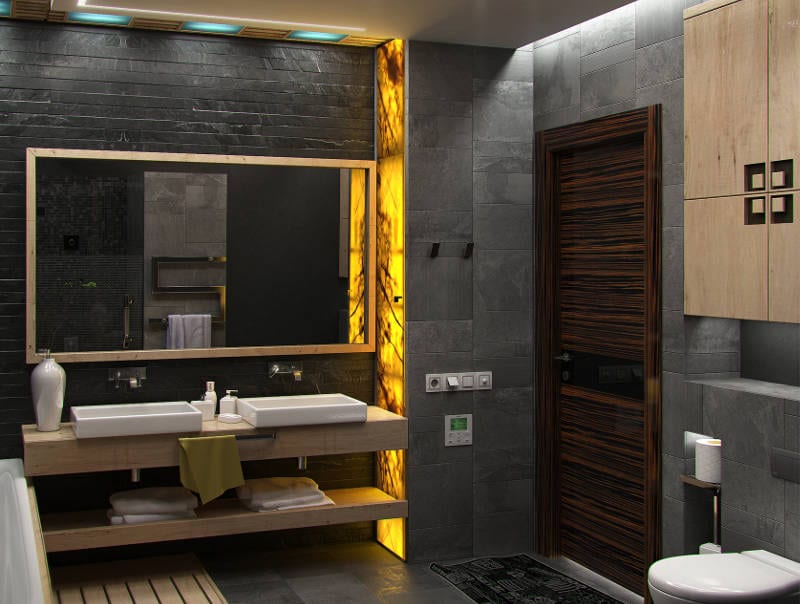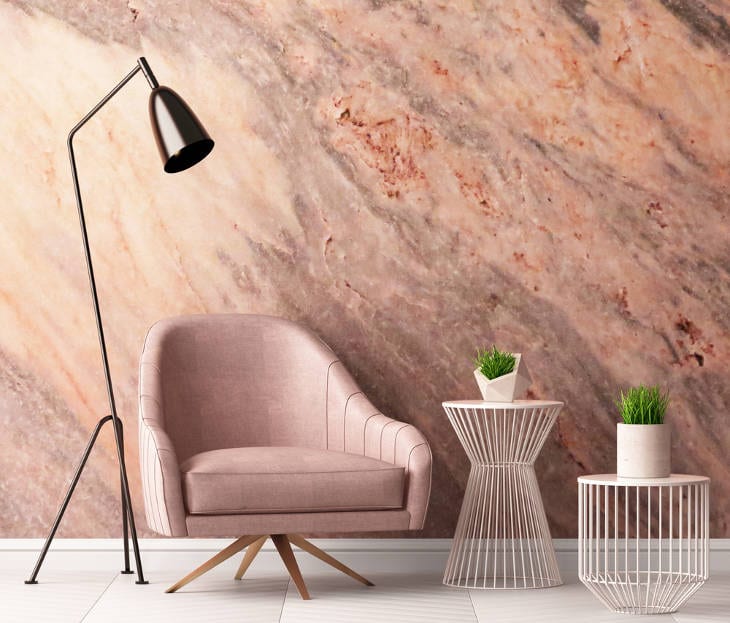onyx
Onyx has been increasingly popular in architecture and interior decoration in recent years. This natural stone works magic when building cozy relaxation corners at home or in public areas. In luxurious hotels and restaurants you will see walls, partitions, stairs, counters and coffee tables fabricated from onyx. When onyx is backlit, the light coming through it acquires a soft, unearthly glow with its shades changing in layers. Yellow and white bands in this translucent stone ripple, merge, separate and meet together again. When the Greeks noticed that white onyx stripes resembled human nails, they gave the stone its name, which in Greek means exactly that - nail.
The gemstone onyx is too expensive and is therefore used scarcely in interiors. Onyx gemstone composition is very similar to that of agate as both of these semi-precious stones are varieties of quartz. The difference lies in the pattern: onyx lines undulate in parallel across the slabs, whereas agate lines are circular. Most often the walls and stairs are made of commercial onyx marble which is softer than precious onyx and much more readily available. It is neither marble nor onyx, but resembles them both. Onyx marbles come in a variety of patterns and in soft, creamy colors. The most common onyx shades are green, yellow, pink and white.

What makes onyx unique?
One of the most attractive aesthetic properties of onyx is its ability to transmit light. Because of translucency, soft colours and bold patterns, onyx walls and counters acquire mysterious look when backlit. Artificial light sources are often installed to strengthen the effect. When combined with hidden strips of LED lights, this stone will make furniture and other elements glow.
Transparency is often the main reason why designers choose onyx over other stones for decoration. Onyx can be creatively used to make walls and partitions, bathroom vanities, window sills. Onyx looks original in luxury nightclubs and restaurants - you've probably seen onyx bar counters, decorative walls and stairs lit up from the inside. Relatively thin and light, onyx panels are suitable for many interior design ideas.
The transparency of onyx slabs depends on their thickness and composition. Onyx sheets of 2-4 cm thick look great as furniture tops and countertops. Onyx is suitable for window sills, less so for stairs and floors (unless you are going to use slippers to walk on them). Onyx can be combined with wood, concrete, steel and glass to create modern and stylish interiors. A translucent onyx strip installed in a bathroom wall, onyx kitchen island or cold fireplace surround from onyx will look amazing.
Sensitive and fragile, onyx slabs do not like changes in temperatures and can therefore only be used indoors. Onyx scratches quickly and needs to be handled more carefully than other decorative stones. It is necessary to protect onyx surfaces from mechanical damage and from changes of temperature. This stone normally is not used in exterior.
onyx fabricators in lithuania
How onyx is formed
The category of commercial onyxes includes stones composed of layered bands of translucent minerals. Most onyx slabs are what geologists call banded calcite, onyx marble, Mexican onyx or Egyptian alabaster. Commercial onyx is classified as marble because it is composed of calcite, the same mineral as limestone, marble and travertine. Onyx marble is distinguished from marble by the abundance of patterns and veins. The gemstone onyx is a banded chalcedony composed mainly of silicon. On the Mohs scale, onyx gemstones have a hardness of 6-7 and onyx marble 3-4.
Onyx marble is formed in springs and underground streams where big amounts of calcite are dissolved. Beautiful crystal formations occur wherever mineral-rich groundwater flows. As the water gushes and pours around, more and more minerals are deposited, gradually forming a crust of calcite crystals. The color differences between the layers are due to differences in the water flow and impurities. Changes in the water are reflected in the onyx layers.
The purest calcite is white or clear, but it can be easily coloured by small amounts of other minerals. The Iron oxide in the water and in the rocks give to onyx its most common yellowish-orange colour. Travertine is also formed in a similar way. The main difference between these two stones is their porosity - travertine resembles a dense sponge, while onyx is as smooth as silk, without holes.

Where onyx is found
Onyx is found in many parts of the world. Most onyx marble slabs come from Brazil, Italy, the USA, Pakistan and India. Large deposits of onyx are found in Greece, Yemen, Uruguay, Argentina, Australia, Canada, China, Mongolia. The Czech Republic, Germany, Indonesia, Madagascar and the UK also have onyx quarries.
How onyx is quarried
In the quarries, onyx blocks are cut vertically in layers, as if the onyx deposits were large layered cakes. Each slab of onyx that is cut away from the block reveals the pattern of sediments that have accumulated over thousands of years. The fascinating thing about this stone is that you never know what the next slice will look like.

onyx properties
- Translucent
- Soft (Mohs 3-4)
- Fragile
- Sensitive to scratching
- Sensitive to temperatures
- Porous – will stain
- Cozy
- Requires sealing every 6-12 months

What is onyx used for?
Decorative walls
Backlit and translucent walls
Table tops and furniture tops
Kitchen countertops
Window sills
Interior accents
Fireplace surrounds
Stairs
Walls
Floor
SPA

How to clean onyx countertops?
Being fragile, onyx can scratch and chip easily, therefore onyx worktops are only suitable for those kitchen areas that are less used. This highly porous stone needs to be cleaned very gently. Onyx surfaces do not like acidic cleaners. Mild soap or pH-neutral dishwashing detergent has to be used instead. The best cleaning option is a special stone cleaner.
Onyx surfaces do not like liquids - moisture left on them for a longer period will leave stains. Stained onyx worktops can only be cleaned with a very soft brush, because harsh scrubbing devices and abrasive cleaners will scratch the stone surface. It is necessary to wipe the soap thoroughly with a damp cloth from onyx countertops before drying. Otherwise, stains may appear.
Onyx worktops and sinks should be sealed at least twice a year with special stone sealers. Apply a small amount of the sealer to a dry cloth, rub it into the stone and let it sit for a few minutes. Then scrub the stone for another few minutes with a new dry cloth. If possible, let the surface dry for 6 hours to allow the sealer to soak in. Stone sealers help to protect onyx surfaces from stains, scratches and acid etching.
























